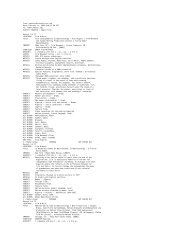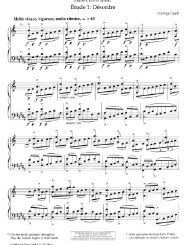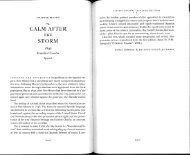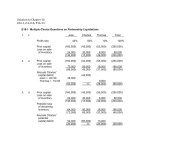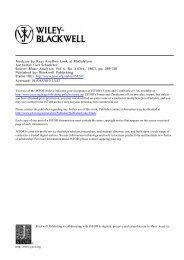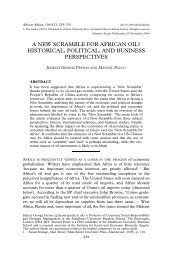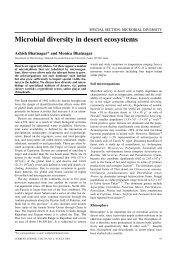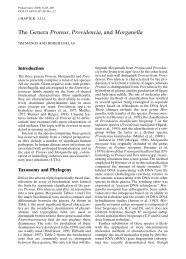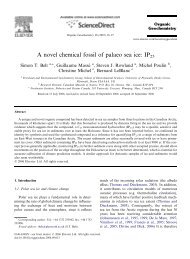The Genus Serratia
The Genus Serratia
The Genus Serratia
Create successful ePaper yourself
Turn your PDF publications into a flip-book with our unique Google optimized e-Paper software.
240 F. Grimont and P.A.D. Grimont CHAPTER 3.3.11<br />
the Mediterranean region. Current Microbiology 7:363–<br />
366.<br />
Grimont, P. A. D., Dulong de Rosnay, H., L. C. 1972. Numerical<br />
study of 60 strains of <strong>Serratia</strong>. Journal of General<br />
Microbiology 72:259–268.<br />
Grimont, P. A. D., Grimont, F. 1978a. <strong>The</strong> genus <strong>Serratia</strong>.<br />
Annual Review of Microbiology 32:221–248.<br />
Grimont, P. A. D., Grimont, F. 1978b. Biotyping of <strong>Serratia</strong><br />
marcescens and its use in epidemiological studies. Journal<br />
of Clinical Microbiology 8:73–83.<br />
Grimont, P. A. D., Grimont, F. 1978c. Proteinase zymograms<br />
of <strong>Serratia</strong> marcescens as an epidemiological tool. Current<br />
Microbiology 1:15–18.<br />
Grimont, P. A. D., Grimont, F. 1981. <strong>The</strong> genus <strong>Serratia</strong> p.<br />
1187–1203. In: Starr, M. P., Stolp, H., Truper, H. G.,<br />
Balows, A., and Schlegel, H. G. (ed.), <strong>The</strong> prokaryotes:<br />
A handbook on habitats, isolation, and identification of<br />
bacteria. Springer-Verlag. Berlin,<br />
Grimont, P. A. D., Grimont, F. 1984. <strong>Genus</strong> <strong>Serratia</strong> Bizio<br />
1823, 288 AL ,p. 477–484. In: Krieg, N. R., and Holt, J. G.<br />
(ed.), Bergey’s manual of systematic bacteriology, vol. 2.<br />
Williams and Wilkins. Baltimore,<br />
Grimont, P. A. D., Grimont, F., Dulong de Rosnay, H. L. C.<br />
1977a. Characterization of <strong>Serratia</strong> marcescens, S. liquefaciens,<br />
S. plymuthica, and S. marinorubra by electrophoresis<br />
of their proteinases. Journal of General<br />
Microbiology 99:301–310.<br />
Grimont, P. A. D., Grimont, F., Dulong de Rosnay, H. L. C.,<br />
Sneath, P. H. A. 1977b. Taxonomy of the genus <strong>Serratia</strong>.<br />
Journal of General Microbiology 98:39–66.<br />
Grimont, P. A. D., Grimont, F., Irino, K. 1982a. Biochemical<br />
characterization of <strong>Serratia</strong> liquefaciens sensu stricto,<br />
<strong>Serratia</strong> proteamaculans, and <strong>Serratia</strong> grimesii sp. nov.<br />
Current Microbiology 7:69–74.<br />
Grimont, P. A. D., Grimont, F., Le Minor, S., Davis, B.,<br />
Pigache, F. 1979a. Compatible results obtained from biotyping<br />
and serotyping in <strong>Serratia</strong> marcescens. Journal of<br />
Clinical Microbiology 10:425–432.<br />
Grimont, P. A. D., Grimont, F., Lysenko, O. 1979b. Species<br />
and biotype identification of <strong>Serratia</strong> strains associated<br />
with insects. Current Microbiology 2:139–142.<br />
Grimont, P. A. D., Grimont, F., Richard, C., Davis, B. R.,<br />
Steigerwalt, A. G., Brenner, D. J. 1978a. Deoxyribonucleic<br />
acid relatedness between <strong>Serratia</strong> plymuthica<br />
and other <strong>Serratia</strong> species with a description of<br />
<strong>Serratia</strong> odorifera sp. nov. (type strain: ICPB 3995).<br />
International Journal of Systematic Bacteriology<br />
28:453–463.<br />
Grimont, P. A. D., Grimont, F., Starr, M. P. 1978b. <strong>Serratia</strong><br />
proteamaculans (Paine and Stansfield) comb. nov., a<br />
senior subjective synonym of <strong>Serratia</strong> liquefaciens<br />
(Grimes and Hennerty) Bascomb et al. International<br />
Journal of Systematic Bacteriology 28:503–510.<br />
Grimont, P. A. D., Grimont, F., Starr, M. P. 1979c. <strong>Serratia</strong><br />
ficaria sp. nov. a bacterial species associated with<br />
Smyrna figs and the fig wasp Blastophaga psenes. Current<br />
Microbiology 2:277–282.<br />
Grimont, P. A. D., Grimont, F., Starr, M. P. 1981. <strong>Serratia</strong><br />
species isolated from plants. Current Microbiology<br />
5:317–322.<br />
Grimont, P. A. D., Irino, K., Grimont, F. 1982b. <strong>The</strong> <strong>Serratia</strong><br />
liquefaciens-S. proteamaculans-S. grimesii complex:<br />
DNA relatedness. Current Microbiology 7:63–68.<br />
Grimont, P. A. D., Jackson, T. A., Ageron, E., Noonan, M. J.<br />
1988. <strong>Serratia</strong> entomophila sp. nov. associated with<br />
amber disease in the New Zealand grass grub Costelytra<br />
zealandica. International Journal of Systematic Bacteriology<br />
38:1–6.<br />
Groscop, J. A., Brent, M. M. 1964. <strong>The</strong> effects of selected<br />
strains of pigmented microorganisms on small freeliving<br />
amoebae. Canadian Journal of Microbiology<br />
10:579–584.<br />
Harpster, M. H., Dunsmuir, P. 1989. Nucleotide sequence of<br />
the chitinase B gene of <strong>Serratia</strong> marcescens QMB1466.<br />
Nucleic Acids Research 17:5395.<br />
Harrison, F. C. 1924. <strong>The</strong> “miraculous” microorganism.<br />
Transactions of the Royal Society of Canada. 18:1–<br />
17.<br />
Hechler, U., Van Den Weghe, M., Martin, H. H., Frére, J.-M.<br />
1989. Overproduced β-lactamase and the outermembrane<br />
barrier as resistance factors in <strong>Serratia</strong><br />
marcescens highly resistant to β-lactamase-stable βlactam<br />
antibiotics. Journal of General Microbiology<br />
135:1275–1290.<br />
Hedges, R. W. 1980. R factors of <strong>Serratia</strong>. 139–156.von Graevenitz,<br />
A., and Rubin, S. J. (ed.) <strong>The</strong> genus <strong>Serratia</strong>. Boca<br />
Raton, CRC Press.<br />
Hefferan, M. 1904. A comparative and experimental study of<br />
bacilli producing red pigment. Zentralblatt für Bakteriologie,<br />
Parasitenkunde, und Infektionskrankheiten,<br />
Abt. 2 11:311–317, 397–404, 456–475, 520–540.<br />
Ismail, G., Som, F. M. 1982. Hemagglutination reaction and<br />
epithelial cell adherence activity of <strong>Serratia</strong> marcescens.<br />
J. Gen. Appl. Microbiol. 28:161–168.<br />
Iverson, K. L., Bromel, M. C., Anderson, A. W., Freeman,<br />
T. P. 1984. Bacterial symbionts in the sugar beet root<br />
maggot, Tetanops myopaeformis (von Röder). Applied<br />
and Environmental Microbiology 47:22–27.<br />
Izawa, H., Nagabayashi, T., Kazuno, Y., Soekawa, M. 1971.<br />
Occurrence of death of chick embryos by <strong>Serratia</strong> marcescens<br />
infection. Japanese Journal of Bacteriology<br />
26:200–204.<br />
Jackson, C. G. Jr., Fulton, M. 1976. A turtle colony epizootic<br />
apparently of microbial origin. Journal of Wildlife Disease<br />
6:466–468.<br />
Jackson, T. A., Pearson, J. F. 1986. Control of the grass<br />
grub, Costelytra zealandica (White) (Coleoptera: Scarabaeidae),<br />
by application of the bacteria <strong>Serratia</strong> spp.<br />
causing honey disease. Bulletin of Entomological<br />
Research 76:69–76.<br />
Janota-Bassalik, L. 1963. Psychrophiles in low-moor peat.<br />
Acta Microbiologica Polonica 12:25–40.<br />
Jessop, H. L., Lambert, P. A. 1985. Immunochemical characterization<br />
of the outer membrane complex of <strong>Serratia</strong><br />
marcescens and identification of the antigens accessible<br />
to antibodies on the cell surface. Journal of General<br />
Microbiology 131:2343–2348.<br />
Jones, J. D., Grady, K. L., Suslow, T. V., Bedbrook, J. R. 1986.<br />
Isolation and characterization of genes encoding two<br />
chitinase enzymes from <strong>Serratia</strong> marcescens. EMBO J.<br />
5:467–473.<br />
Joshi, S., Kozlowski, M., Richens, S., Comberbach, D. M.<br />
1989. Chitinase and chitobiase production during fermentation<br />
of genetically improved <strong>Serratia</strong> liquefaciens.<br />
Enzyme Microb. Technol. 11:289–296.<br />
Kamata, R., Yamamoto, T., Matsumoto, K., Maeda, H. 1985.<br />
A <strong>Serratia</strong>l protease causes vascular permeability reaction<br />
by activation of the Hageman factor-dependent<br />
pathway in guinea pigs. Infection and Immunity 48:747–<br />
753.<br />
Kaska, M. 1976. <strong>The</strong> toxicity of extracellular proteases of the<br />
bacterium <strong>Serratia</strong> marcescens for larvae of greater wax



